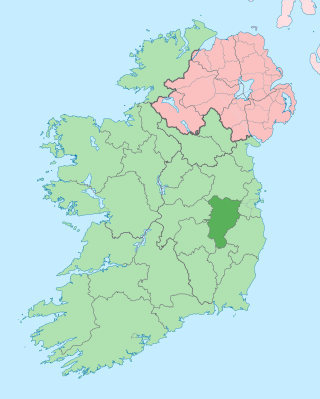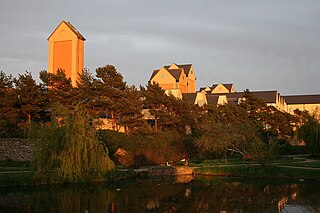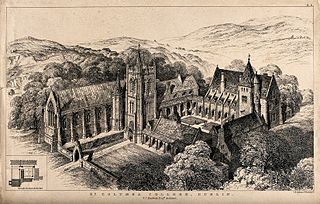
The Pale or the English Pale was the part of Ireland directly under the control of the English government in the Late Middle Ages. It had been reduced by the late 15th century to an area along the east coast stretching from Dalkey, south of Dublin, to the garrison town of Dundalk. The inland boundary went to Naas and Leixlip around the Earldom of Kildare, towards Trim and north towards Kells. In this district, many townlands have English or French names, the latter associated with Norman influence in England.

County Kildare is a county in Ireland. It is in the province of Leinster and is part of the Eastern and Midland Region. It is named after the town of Kildare. Kildare County Council is the local authority for the county, which had a population of 246,977 at the 2022 census.

Naas is the county town of County Kildare in Ireland. In 2022, it had a population of 26,180, making it the largest town in County Kildare and the fourteenth-largest urban center in Ireland.

Cecil Frances Alexander was an Anglo-Irish hymnwriter and poet. Amongst other works, she wrote "All Things Bright and Beautiful", "There is a green hill far away" and the Christmas carol "Once in Royal David's City".
The Carnew executions refer to the summary execution of 28 prisoners being held as suspected United Irishmen by yeomanry troops from the Carnew garrison stationed in the barracks of Carnew Castle, County Wicklow, Ireland on 25 May 1798.

Adrian Dunbar is an Irish actor, director and singer, known for his television and theatre work. He co-wrote and starred in the 1991 film Hear My Song, nominated for Best Original Screenplay at the BAFTA awards.
Bryan Murray is an Irish actor. He is known for his extensive television work which includes Fitz in Strumpet City, Flurry Knox in The Irish R.M., Shifty in Bread, Harry Cassidy in Perfect Scoundrels, Trevor Jordache in Brookside and Bob Charles in Fair City.

St Columba's College is a co-educational independent day and boarding school founded in 1843 located in Whitechurch, County Dublin, Ireland. Among the founders of the college were Viscount Adare, William Monsell, Dr William Sewell and James Henthorn Todd.
Castlemartyr was a constituency represented in the Irish House of Commons from 1676 to 1800.
Carlow was a constituency representing the borough of Carlow in the Irish House of Commons, the lower house in the Irish Parliament of the Kingdom of Ireland. It returned two members to the Parliament of Ireland from 1613 to 1800.
Kinsale was a constituency represented in the Irish House of Commons until 1800.

Charles Frederick D'Arcy was a Church of Ireland bishop. He was the Bishop of Clogher from 1903 to 1907 when he was translated to become Bishop of Ossory, Ferns and Leighlin before then becoming the Bishop of Down, Connor and Dromore. He was then briefly the Archbishop of Dublin and finally, from 1920 until his death, Archbishop of Armagh. He was also a theologian, author and botanist.
Harristown was a borough constituency in the Irish House of Commons until 1800, representing the borough of Harristown in the barony of Naas South, County Kildare.

Leixlip is a town in north-east County Kildare, Ireland. Its location on the confluence of the River Liffey and the Rye Water has marked it as a frontier town historically: on the border between the ancient kingdoms of Leinster and Brega, as an outpost of The Pale, and on Kildare's border with County Dublin. Leixlip was also a civil parish in the ancient barony of Salt North.

Colonel Thomas de Burgh, always named in his lifetime as Thomas Burgh, was an Anglo-Irish military engineer, architect, and Member of the Parliament of Ireland who served as Surveyor General of Ireland (1700–1730) and designed a number of the large public buildings of Dublin including the old Custom House (1704–6), Trinity College Library (1712–33), Dr Steevens' Hospital (1719), the Linen Hall (1722), and the Royal Barracks.

Richard Óg de Burgh, 2nd Earl of Ulster and 3rd Baron of Connaught, called The Red Earl, was one of the most powerful Irish nobles of the late 13th and early 14th centuries and father of Elizabeth, wife of King Robert the Bruce of Scotland.
Philip Flattisbury, was an Irish compiler.
William Maunsell Hennessy (1829–1889) was an Irish official and scholar.

Jigginstown Castle is a ruined 17th-century house and National Monument near Naas, County Kildare, Ireland. It was constructed in the late 1630s when Ireland was under the reign of Charles I (1625–1649). At the time it was one of the largest buildings in Ireland, and the first to be constructed of red brick said to have been imported from Holland: the plans provided for pavement and columns of Kilkenny marble.
Francis Spring was an Anglo-Irish politician.









